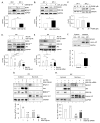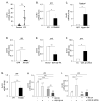Idiopathic pulmonary fibrosis fibroblasts become resistant to Fas ligand-dependent apoptosis via the alteration of decoy receptor 3
- PMID: 27218286
- PMCID: PMC4993669
- DOI: 10.1002/path.4749
Idiopathic pulmonary fibrosis fibroblasts become resistant to Fas ligand-dependent apoptosis via the alteration of decoy receptor 3
Abstract
Idiopathic pulmonary fibrosis (IPF) is an irreversible lethal lung disease with an unknown etiology. IPF patients' lung fibroblasts express inappropriately high Akt activity, protecting them in response to an apoptosis-inducing type I collagen matrix. FasL, a ligand for Fas, is known to be increased in the lung tissues of patients with IPF, implicated with the progression of IPF. Expression of Decoy Receptor3 (DcR3), which binds to FasL, thereby subsequently suppressing the FasL-Fas-dependent apoptotic pathway, is frequently altered in various human disease. However, the role of DcR3 in IPF fibroblasts in regulating their viability has not been examined. We found that enhanced DcR3 expression exists in the majority of IPF fibroblasts on collagen matrices, resulting in the protection of IPF fibroblasts from FasL-induced apoptosis. Abnormally high Akt activity suppresses GSK-3β function, thereby accumulating the nuclear factor of activated T-cells cytoplasmic 1 (NFATc1) in the nucleus, increasing DcR3 expression in IPF fibroblasts. This alteration protects IPF cells from FasL-induced apoptosis on collagen. However, the inhibition of Akt or NFATc1 decreases DcR3 mRNA and protein levels, which sensitizes IPF fibroblasts to FasL-mediated apoptosis. Furthermore, enhanced DcR3 and NFATc1 expression is mainly present in myofibroblasts in the fibroblastic foci of lung tissues derived from IPF patients. Our results showed that when IPF cells interact with collagen matrix, aberrantly activated Akt increases DcR3 expression via GSK-3β-NFATc1 and protects IPF cells from the FasL-dependent apoptotic pathway. These findings suggest that the inhibition of DcR3 function may be an effective approach for sensitizing IPF fibroblasts in response to FasL, limiting the progression of lung fibrosis. Copyright © 2016 Pathological Society of Great Britain and Ireland. Published by John Wiley & Sons, Ltd.
Keywords: Akt; DcR3; FasL; GSK-3β; IPF; NFATc1; apoptosis; collagen.
Copyright © 2016 Pathological Society of Great Britain and Ireland. Published by John Wiley & Sons, Ltd.
Conflict of interest statement
Authors declare no conflict of interest.
Figures






References
-
- Gharaee-Kermani M, Gyetko MR, Hu B, et al. New insights into the pathogenesis and treatment of idiopathic pulmonary fibrosis: a potential role for stem cells in the lung parenchyma and implications for therapy. Pharm Res. 2007;24:819–841. - PubMed
-
- Ryu JH, Colby TV, Hartman TE. Idiopathic pulmonary fibrosis: current concepts. Mayo Clin Proc. 1998;73:1085–1101. - PubMed
Publication types
MeSH terms
Substances
Grants and funding
LinkOut - more resources
Full Text Sources
Other Literature Sources
Research Materials
Miscellaneous

